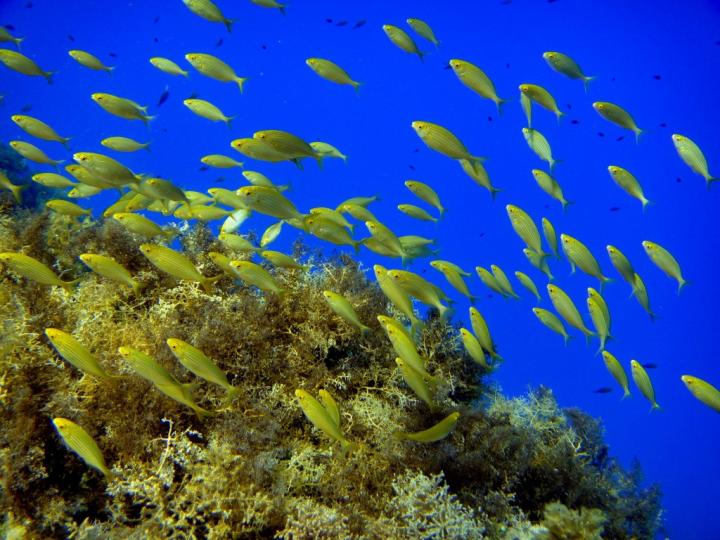Experts identify three large areas in which there is barely fish exchange

Credit: Enrique Ballesteros (CEAB-CSIC)
A new study analyzes the larval dispersal of nine fish species in the western Mediterranean and identifies three large areas in which there is barely fish exchange, so fish would remain in the same area all their life.
The study, published in the journal Progress in Oceanography, is led by experts of the Faculty of Biology of the University of Barcelona and the Biodiversity Research Institute (IRBio) of the UB, the Blanes Center for Advanced Studies (CEAB-CSIC), the Balearic Islands Coastal Observing and Forecasting System (ICTS – SOCIB), and the Mediterranean Institute for Advanced Studies (IMEDEA, CSIC-UIB).
The three identified areas are the Balearic Sea, the West Algerian Basin, and the Alboran Sea. These marine areas are separated by oceanographic discontinuities that act as barriers, in this case the Ibiza channel and the Almeria-Oran front, two fronts that are hard to cross for fish larvae due to the difficult circulation and exchange of water masses.
These results are relevant for the setting of protecting areas since many of the demersal fish species -those living in seafloors- are sedentary in their adult life and barely move. However, when these are under the larval phase, they move across the currents mainly, a moment when they are more likely to distribute around outside their birth place.
Low Exchange between marine areas
The studied species are the common two-banded sea bream (Diplodus vulgaris), the white seabream (Diplodus sargus), the sheephead bream (Diplodus puntazzo), the dreamfish (Sarpa salpa), the saddle bream (Oblada melanuria), the damselfish (Chromis chromis), the Mediterranean rainbow wrasse (Coris julis), the ocellated wrasse (Symphodus ocellatus) and the East Atlantic peacock wrasse (Symphodus tinca). These species are abundant and present differences at a trophic level, the reproductive seasons and ways and the length of the larval phase (from 7 to 43 days and egg-laying in different seasons).
“Also, there is individualized information of these species on the birth date and larval life length according to a previous study”, notes Hèctor Torrado, researcher at CEAB-CSIC and UB-IRBio, and lead author of the study. “This enabled the modelling of the dispersal at an individual level and to infer the potential origin of each individual”, he adds.
“Our study shows that the three identified areas present a low exchange of individuals of all species and that should be considered three hydrodynamics units”, notes Enrique Macpherson, researcher at CEAB-CSIC and co-author of the study. This information is relevant regarding the marine reserve setting.
Reserves must guarantee connectivity
In order for them to be effective, marine reserves should work as a network that allows an interconnection between them at a populational level. This enables a flux of species and individuals that ensure its efficiency in the conservation of marine ecosystems.
“Therefore, inside every hydrodynamic unit, there can be a good network of interconnected areas but this connection will be weak between units. This information has to be considered when designing a network of protected areas including different areas”, notes Marta Pascual, lecturer at the Faculty of Biology and UB-IRBio and co-author of the study.
Most of the fish spend their life in the same oceanographic region where they were born. However, there are some exceptions. For instance, the Balearic Sea features individuals that were born in the same area but some could have arrived from the north, Provençal waters and the Ligurian Sea.
Experts also consider reproductive periods of species as an important factor (egg-laying, hatching period, and the length of the larval period). As the study states, there are seasonal changes in the oceanographic barriers that affect their permeability and as a result, the larval crossing across these barriers. Also, the speed and direction of currents can change over the year, which also affects the larval dispersal and connectivity between areas.
Moreover, there are areas with a higher variation, not only seasonal but also interannual, which can change connectivity between localities at an evolutionary scale.
The dynamics and seasonal variations of water masses can determine the connectivity patterns of these species, experts say. Regarding how much these results of nine species could be extrapolated to other species, scientists say that “in theory, most of coastal fish of western Mediterranean could be extrapolated since we see that the three hydrodynamic units are detected in different species that reproduced in different seasons and with a different larval life length”.
“Nevertheless, at a small scale, we observe the importance of the birthdate in the origins of larvae that settle in a place, suggesting that both direction and distance are influenced by the oceanographical variables of the area”, conclude the experts.
###
Media Contact
Rosa Martínez
[email protected]
Original Source
https:/
Related Journal Article
http://dx.




